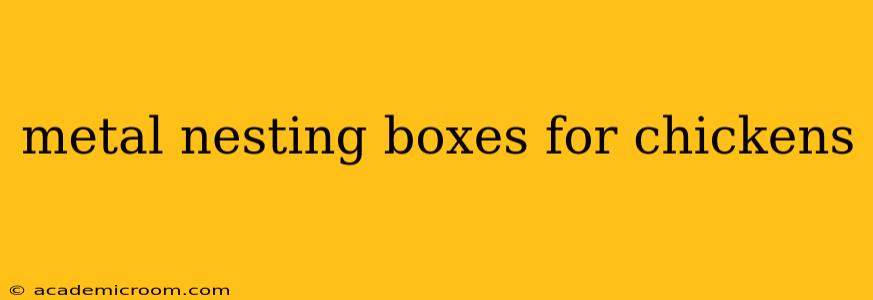Choosing the right nesting boxes is crucial for happy, healthy hens and easy egg collection. While wooden nesting boxes are traditional, metal nesting boxes offer a unique set of advantages and disadvantages. This comprehensive guide explores the pros and cons of metal nesting boxes for chickens, addressing common questions and concerns.
Why Choose Metal Nesting Boxes?
Metal nesting boxes are gaining popularity among chicken keepers for several reasons:
- Durability: Unlike wood, metal is resistant to rot, pests, and damage from pecking. This longevity translates to a longer lifespan for your investment.
- Easy Cleaning: Metal surfaces are easily cleaned and sanitized, reducing the risk of bacterial contamination and disease. A quick wipe-down is often all that's needed.
- Pest Resistance: Metal is less susceptible to infestations from rodents, insects, and mites compared to wooden boxes. This can significantly simplify maintenance.
- Weather Resistance: Many metal nesting boxes are designed to withstand harsh weather conditions, protecting eggs from rain and excessive humidity.
What are the Disadvantages of Metal Nesting Boxes?
While metal offers numerous benefits, there are some drawbacks to consider:
- Temperature Extremes: Metal can get very hot in direct sunlight and very cold in freezing temperatures. This might make the boxes uncomfortable for your hens, especially in extreme climates. Consider providing shade or insulation in hot weather.
- Potential for Condensation: In humid climates, condensation can form on the metal surfaces, potentially leading to dampness within the box. Proper ventilation is essential.
- Cost: Metal nesting boxes are often more expensive than their wooden counterparts, although the long-term durability can offset this initial investment.
- Feel: Some hens might find the cold, hard surface of metal less comfortable than the softer feel of wood.
Are Metal Nesting Boxes Cold in Winter?
Yes, metal nesting boxes can get cold in winter, especially in areas with harsh climates. To mitigate this, consider adding insulation to the inside of the box, using straw or other bedding materials in generous quantities, or placing the nesting boxes in a sheltered area of the coop.
How Do I Clean a Metal Nesting Box?
Cleaning metal nesting boxes is straightforward. Simply remove the soiled bedding, then wash the box with warm soapy water. A disinfectant solution can be used for thorough sanitization. Allow the box to dry completely before replacing the bedding.
Are Metal Nesting Boxes Better Than Wooden Nesting Boxes?
There's no single "better" option; the ideal choice depends on your specific needs and climate. Metal offers durability and easy cleaning, while wood provides a more natural, potentially warmer feel. Consider the pros and cons of each to determine what works best for your flock and environment.
What Size Should My Metal Nesting Box Be?
The size of your nesting box should accommodate the size of your hens comfortably. Generally, a box of approximately 12" x 12" x 12" is suitable for most breeds. However, larger breeds might benefit from slightly larger boxes.
Do Chickens Prefer Metal or Wooden Nesting Boxes?
This is subjective and depends on the individual hen. Some hens might readily adapt to metal boxes, while others might prefer the softer feel of wood. Observing your hens' behavior after introducing the boxes will help determine their preference.
How Much Do Metal Nesting Boxes Cost?
The cost varies depending on the size, features, and brand. Prices range from relatively inexpensive to quite high for more sophisticated models. Shop around to compare prices and features.
By carefully weighing the advantages and disadvantages, and considering the needs of your flock and climate, you can make an informed decision about whether metal nesting boxes are the right choice for your chicken coop. Remember, a happy hen is a productive hen!
